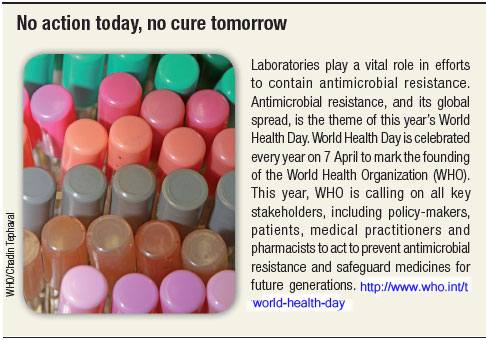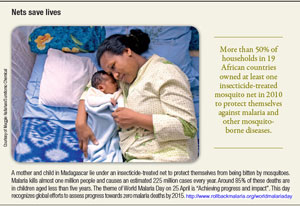NEWS
Public health round-up

Top 30 lifesavers
For the first time, WHO has issued a list of 30 priority medicines for maternal and child health that tells countries which medicines are most important for saving lives. Top medicines to treat mothers include oxytocin (to prevent severe bleeding after giving birth), medicines to treat infection, high blood pressure and sexually transmitted infections as well as drugs to prevent preterm birth. For children, the priority drugs include antibiotics, oral rehydration salts and zinc tablets, antimalarials and antiretrovirals. Medicines appropriate for children are often not available, forcing health workers to adapt adult medicines. Tablets are crushed into imprecise portions and dissolved into unpalatable drinks that are difficult for children to swallow and are potentially ineffective or toxic. "Medicines produced in liquid form are more expensive than tablets or powders and are also more difficult to store, package and transport, due to their bulk, weight and need for refrigeration. The list we have drawn up tells manufacturers exactly what they should be producing to meet countries' needs," said Dr Hans Hogerzeil, director of WHO's Department for Essential Medicines and Pharmaceutical Policies.
Made in China
Vaccines from China could soon be used in global health programmes following the decision on 1 March to grant the Chinese State Food and Drug Administration (SFDA) the right to regulate vaccine manufacturing. A comprehensive WHO-led review has concluded that the national regulatory authority of China complies with international standards for a functional vaccine regulatory system. This means that Chinese vaccine manufacturers are now eligible to apply for WHO prequalification and to supply vaccines to a global market.
Vaccine vigilance
In the lead-up to European Immunization Week (23-30 April), WHO's Regional Director for Europe, Zsuzsanna Jakab called for vigilance against vaccine-preventable diseases. Speaking on 3 March at a conference on childhood immunization in Budapest, Hungary, she expressed concern about the decline in vaccine acceptance in some European populations. "We stand at a crossroads in Europe, risking losing many of the gains that our predecessors in public health have made," she said. "In 2010, we witnessed large-scale outbreaks of measles and rubella and we saw the re-emergence of polio in the WHO European Region, which had been free of polio cases for more than 10 years." The 53 Member States of the region have adopted a resolution to eliminate measles and rubella from the region by 2015.
SE Asia's double burden
Adults aged between 35 and 60 years in the WHO South-East Asia Region are dying from noncommunicable diseases at a much higher rate than adults of the same age group in developed countries. The region is in the midst of an epidemiological transition - while infectious diseases are still highly prevalent, noncommunicable diseases are emerging as an important public health threat, accounting for an estimated 8 million deaths annually, or 22% of global deaths. This burden is predicted to increase significantly, due to ageing populations, unplanned urbanization and increased unhealthy lifestyles among countries in this region. Member States met in March in Jakarta, Indonesia, to prepare a regional response for the United Nations General Assembly meeting in September on the prevention and control of noncommunicable diseases.
Gender determines risks
While chronic diseases are the leading cause of death for both men and women worldwide, differences in gender roles affect disease incidence and outcomes. At a meeting held on 25 February in New York, experts called for a gender-specific approach to tackling chronic diseases. "Chronic noncommunicable diseases are predominantly behaviour or lifestyle diseases," said Dr Marijke Velzeboer, senior advisor on gender, diversity and human rights at the WHO Regional Office for the Americas. "These diseases and their risk factors are very much influenced by roles and expectations in society." Important gender differences include the fact that women tend to be affected by chronic diseases at younger ages than men; they live longer but with less social protection; and are often the main carers for sufferers of chronic diseases.
Just published
WHO's Department of Reproductive Health and Research has released new guidelines for the induction of labour in under-resourced settings. Up to 25% of all deliveries at term involve the artificial initiation of labour. Based on 18 up-to-date Cochrane systematic reviews, these guidelines are aimed at obstetricians, midwives, general practitioners, health-care managers and public health policy-makers. http://whqlibdoc.who.int/publications/2011/9789241501156_eng.pdf
Genetics neglected
WHO has issued the first global report on community genetics services in low- and middle-income countries, where the prevention and care of congenital disorders and genetic diseases is often neglected. The report calls for more services such as genetics counselling of parents-to-be, prenatal and newborn screening, while emphasizing the need to respect individual reproductive decisions. http://whqlibdoc.who.int/publications/2011/9789241501149_eng.pdf
Research scan
Mapping disease
A study from the WHO Region for the Americas shows strong hope for the elimination of some neglected diseases. For the first time, the study maps the region's disease "hotspots" of lymphatic filariasis, onchocerciasis, schistosomiasis, human rabies, trachoma and soil-transmitted parasites, and identifies critical areas for intervention. The paper, published in February in the Public Library of Science Neglected Tropical Diseases journal, concludes that the goal of elimination or drastic reduction of these diseases is achievable in this region. http://www.plosntds.org/article/info:doi/10.1371/journal.pntd.0000964
Relatives ignore risk
Young people with a family history of skin cancer are ignoring sun-safety advice, according to research published in February in BioMed Central Public Health. Researchers at the Cancer Institute of New Jersey, United States of America, surveyed more than 500 people whose family members had had melanoma, the most dangerous form of skin cancer. Although most surveyed were aware of the protective effects of sunscreen, many of them did not use any form of sun protection. Younger women in particular still viewed a tan as being healthy and were the least likely to use sunscreen. http://www.biomedcentral.com/1471/2458/11/122.pdf 
Looking ahead
7 April: World Health Day
25 April: World Malaria Day
28-29 April: Russian Ministerial Conference on noncommunicable diseases and healthy lifestyles http://www.who.int/nmh/events/moscow_ncds_2011
11 May: Launch of the Decade of Action for Road Safety 2011-2020 http://www.who.int/roadsafety/decade_of_action
12 May: International Nurses Day http://www.icn.ch/publications/international-nurses-day
17-21 May: World Health Assembly http://www.who.int/governance/en/index.html.
31 May: World No Tobacco Day http://www.who.int/tobacco/wntd/2011/announcement/en/index.html
5 June: World Environment Day http://www.unep.org/wed
14 June: World Blood Donor Day http://wbdd.org
26 June: International Day against Drug Abuse and Illicit Trafficking http://www.unodc.org/drugs/june-26

